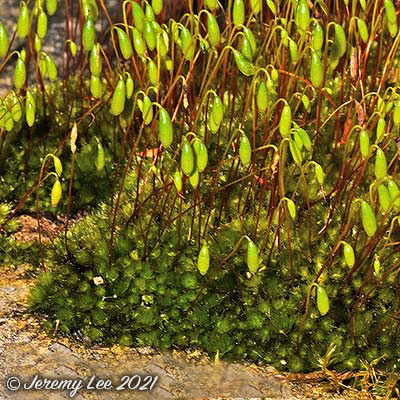
 |
|
Scientific Classifications explained » Amphibians » Ants » Aphids » Bees » Beetles » Birds » Bugs » Butterflies » Caterpillars » Damselflies » Dragonflies » Earwigs » Flies » Frog/Leafhoppers » Fungi » Galls » Grasshoppers » Harvestmen » Hoverflies » Lacewings » Ladybirds » Leaf Mines » Lichens » Mammals » Millipedes » Mosses » Moths » Sawflies » Slugs » Snails » Spiders » Trees & Shrubs » Wasps » Wild Flowers » Woodlice » Postboxes |
UK Nature > Mosses > Mnium hornum

Scientific Name: Mnium hornum Common Name: Swan's-neck Thyme-moss Mnium hornum, or as it is more commonly known, Swan’s-neck thyme-moss, is one of Britain’s most common mosses. It is a dark, dull green, with large 'leaves' that are almost fern like and velvety. In spring the new, almost yellow leaves contrast with the older, dark-green leaves. In the UK it is often found in damp woodland conditions, particularly when the soil is acidic. Typically, this is in oak-birch woodlands, but also beech or pine woods. It is abundant on the ground, but also grows on logs, rocks, tree bases and along stream banks. The stalks (seta) that support the spore capsules are dark reddish-brown and yellowish-green above, upright, 2–4cm tall, densely hairy. The spore capsules (sporophytes) are produced by female plants. They are 5mm long with the lid narrowing abruptly into a very short point. |
|

https://www.uknature.co.uk is a website dedicated to showing the immense diversity of UK nature and wildlife. Our vast range of habitats, from lowland arable to snow covered mountains, from storm-ravaged coastlines to peaceful inland freshwater lakes and rivers, from dry, sandy heaths to deciduous and coniferous forests, all these habitats contribute to the abundance of UK nature. We have wild birds in huge numbers either residing or visiting our shores (597 recorded species as at July 2013) and we must also not forget the humble back garden with its grass lawns, flower beds filled with nectar rich flowers, shrubs and trees, all designed to attract huge numbers of insects such as bees, moths, butterflies and hoverflies; and finally the small ponds which provide safe havens for frogs, toads, newts and even slow worms and grass snakes. www.uknature.co.uk is the showcase for my personal passion, photographing uknature in all its glory. I sincerely hope you all enjoy the fruits of my labours. This site and all images contained therein is © Jeremy Lee 2004 - 2025. All Rights Reserved. Site design by Jeremy Lee. Site development & IT Support by Stuart Lee. |